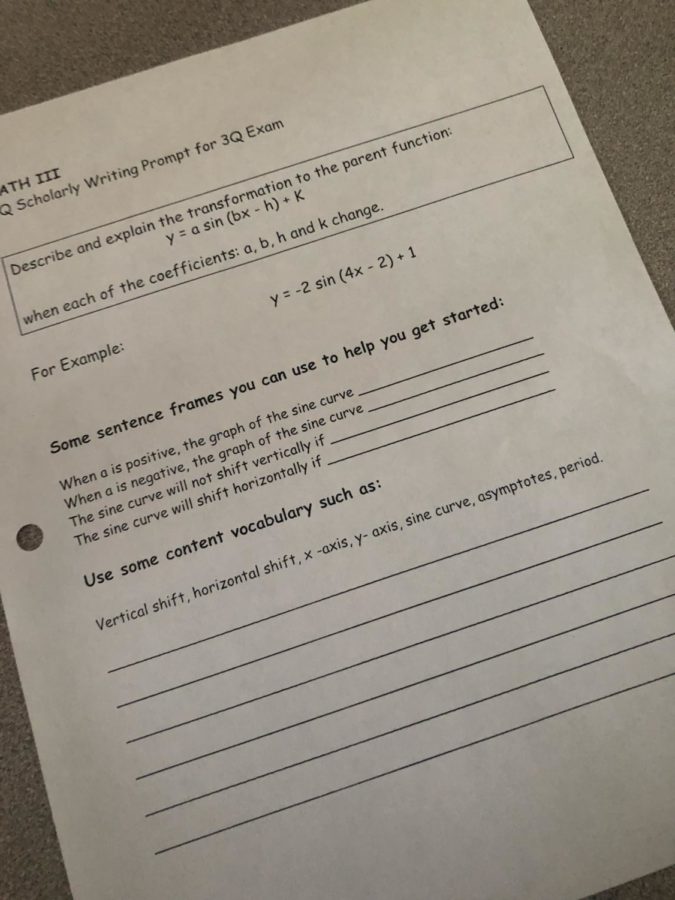The Write Thing
May 15, 2019
Most students are noticing more writing being implemented into their classes. Some are wondering, why?
BUHS is accredited by an organization called WASC (Western Association of Schools and Colleges) which requires the administration to develop an action plan that continually improves learning for all students. Teachers and administration come up with an “action plan” to decide what students need more of and what has been lacking in studies. Principal Randy Cook says, “Writing school-wide is in our WASC Action Plan and scheduled for implementation of the 2018-2019 school year.”
Our administration and school board want to see writing implemented “school-wide” not just in core classes. They want to uphold a higher standard of literacy in our schools. As Cook states, “The Standards also lay out a vision of what it means to be a literate person in the twenty-first century.”
Writing is used as a research-based strategy that teachers have been trained to incorporate into lessons, it’s used as a “subject area” thinking and writing skill. “There is a strong relationship between clear and critical/analytical thinking and writing.”
Most people don’t understand why writing needs to be used more. Maybe it doesn’t apply to your chosen career field or doesn’t interest you at all. Cook indicates, “It is an unfortunate mistake for a student to underestimate the importance of being able to clearly articulate their ideas and thoughts through writing. On a fundamental level, a student who has strong writing skills is going to experience many more opportunities for advancement in the workplace than a student who has weak skills.”
Principal Cook was gracious enough to sit down and answer my questions as to why there has been more writing in the classroom. Here are his responses:
Q: Students are noticing more writing being implemented into classes like math and science why is this?
A: Actually, we want to see an increase in writing school-wide and writing as a learning and assessment tool should be distributed in all content areas. We are mandated by the California Department of Education to integrate and follow the Common Core State Standards (CCSS) as a blueprint for our curriculum planning and teaching. The CCSS are designed as an integrated model of literacy so it is a shared responsibility for all teachers to help develop writing skills. The CCSS were developed so schools can produce students that are College and Career ready.
But these standards are much more than this. The intro to the CCSS states that “the Standards also lay out a vision of what it means to be a literate person in the twenty-first century.” The CCSS focuses on teaching students to be able to write over a range of lengths, forms, contexts, topics, and purposes. Students are supposed to be taught to write arguments focused on discipline-specific content.
Finally, if you look at the standards themselves, you will see that there are standards called “WHST” which stands for Writing Standards for Literacy in History/Social Studies, Science, and Technical Subjects 6-12. Math, for example, is considered a technical subject. The standards demand writing in all core content areas and have specific standards that address this.
Q: How is writing being implemented into classes?
A: Writing is being implemented utilizing research-based strategies our teachers have been trained in that incorporate content (subject area) specific thinking and writing skills. There is a strong relationship between clear and critical/analytical thinking and writing.
Q: Whose idea was it to bring more writing into these kinds of classes?
A: BUHS is accredited by an organization called WASC (Western Association of Schools and Colleges) which requires us to develop an action plan that continually improves learning for all students. This action plan is developed by the teachers and administrators who work together to identify school-wide goals and accompanying strategies to meet the goals. The CCSS should be the guide to help identify and target curriculum objectives which should be aligned to these standards.
Writing school-wide is in our WASC Action Plan and scheduled for implementation of the 2018-2019 school year. So, here we are. It is also important to remember that we have always utilized writing in some way, shape or form in all subject areas.
Q: What is supposed to be accomplished by adding more writing into classes?
A: Academic achievement for all students will improve because of the writing to learn strategy currently being implemented at BUHS. The strategy currently being implemented focuses on teachers explicitly teaching students how to use content-specific thinking, writing, reading and speaking skills. The writing frequency has to increase for students to benefit from these strategies. We want to increase the quantity and quality of writing which will produce proficient writers, critical thinkers, and students who possess stronger academic skill sets that will help them be successful in college/career and an educated participant in our democracy.
Q: How is implementing more writing going to help further students?
A: It is an unfortunate mistake for a student to underestimate the importance of being able to clearly articulate their ideas and thoughts through writing. On a fundamental level, a student who has strong writing skills is going to experience many more opportunities for advancement in the workplace than a student who has weak skills.
Yet this point goes far beyond dollars and cents. If you look at Appendix A of the CCSS, it explains in great detail and clarity how the writing standards are divided into three types of writing and the purpose of each form and they are as follows: Argument, Informational/Explanatory Writing and Narrative Writing. The writer points out that while all forms are important, there is a special place in the CCSS for writing arguments.
As you are probably aware, we have a fairly substantial focus on this type of writing in our ELA courses generally focusing on evaluating an author’s argument on a given topic or prompt and the strategies used to convince an audience. The need for students to develop skills to analyze an author’s argument, and then write (and speak) their own effective arguments (and counter-arguments) are central to both college and career success.
But Appendix A points out something much more important regarding this topic:
The value of effective argument extends well beyond the classroom or workplace, however. As Richard Fulkerson (1996) puts it in Teaching the Argument in Writing, the proper context for thinking about argument is one “in which the goal is not victory but a good decision, one in which all arguers are at risk of needing to alter their views, one in which a participant takes seriously and fairly the views different from his or her own” (pp. 16–17). Such capacities are broadly important for the literate, educated person living in the diverse, information-rich environment of the twenty-first century.
I hope you would agree that in the hyperpolarized, social media-driven society we are living in at the moment, this skill is more important than ever before.



